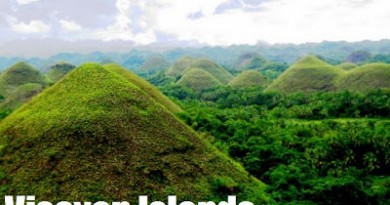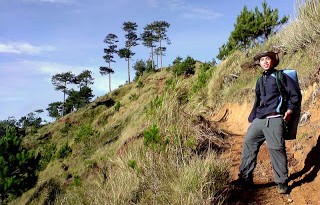New system of classifying mountains
PinoyMountaineer.com classification system, version 1
by Gideon Lasco
To address the need for a more precise classification, PinoyMountaineer is adopting a new system which will enable the classification and characterization not just of mountains but of all outdoor destinations in the Philippines.
The old ‘fact sheet’ we used consisted of (1) elevation; (2) level; and (3) days required. Among these three, only ‘Level’ gives an idea of difficulty. Elevation is useless because what is more important is altitude gain. Furthermore, the old system do not have an idea of how long it takes an average climber to reach the summit, which is considered by many as an important gauge to assess a climb. Finally, a three-level system does not distinguish between DIFFICULT and VERY DIFFUCULT or EASY and VERY EASY.
Thus, we are adopting a new difficulty scale, of 9 grades. This system is RELATIVE scale that is used to compare one mountain with another. Mt. Guiting-Guiting, Mt. Halcon, and Mt. Patukan are considered 9/9 and the minor waterfalls trips are 1/9. Length of the hike, preparations required, including the travel time from the nearest major city (i.e. Manila, Baguio, Davao), as well as extremes of environment are considered. The most commonly used trail is considered for each mountain; articles featuring a particular trail will have their own classification apart from the mountain itself: Akiki Trail is 7/9 whereas Ambangeg is 5/9. This system is primarily for local mountaineers who have experienced climbing the mountains themselves.
Major/Minor classification: This has been used by local mountaineers, but we are making the distinction more exact: Destinations that can be negotiated within 5 hours (i.e. can be daytripped) without extraordinary effort are considered MINOR; the rest are considered MAJOR. The label “climb” is avoided as outdoor destinations may be likewise classified. The Level I-IV system is abolished.
Another addition is “Trail class”. It is an internationally-recognizable, ABSOLUTE scale:
1 – Walking (easy stroll)
2 – Hiking along a path/rugged terrain
3 – Scrambling (using hands for balance)
4 – Climbing easy cliffs but with enough drop off- beginners should be roped.
5 – Using free hands as climbing method
6 – very difficult and need to use artificial method
Since most climbs involve different trail classes, the most predominant class is put first, with other legs put in parenthesis. Required maneuvers, such as river crossing, rappelling, or swimming will also be included. We are including this so that foreign visitors will have an idea what a particular mountain would entail in terms of preparations. There are other international scales; others include the amount of energy (calories) a climber would use but these systems are still impractical for our setting.
These three, (1) Difficulty scale; (2) Major/minor classification; and (3) Trail class form the “Specs” of each outdoor destination. We have a basic Major/Minor classification, adopted from the old itineraries; we also have a relative scale as well as an absolute scale. Finally, the “Specs” can be applied universally and can be understood universally also.
Here are examples of the proposed “Specs”:
Taytay Falls: Minor, Difficulty 1/9, Trail Class 1
Mt. Maculot: Minor, Difficulty 2/9, Trail Class 2-3
Mt. Batulao: Minor, Difficulty 3/9, Trail Class 2-3
Tarak Ridge: Major, Difficulty 4/9, Trail Class 2-3
Mt. Pulag via Ambangeg: Major, Difficulty 5/9, Trail Class 2
Mt. Tapulao: Major, Difficulty 6/9, Trail Class 2
Mt. Apo via Kidapawan: Major, Difficulty 7/9, Trail Class 2-4
Mt. Dulang-Dulang: Major, Difficulty 8/9, Trail Class 2-4
Mt. Patukan: Major, Difficulty 9/9, Trail Class 2 with rappelling, river crossing
In addition, “hours to summit” and “days required” will be included in the primary information parameters included in each article. These, however, are admittedly subjective, and serves only as a guide. Finally, instead of just mentioning altitude, LLA (latitude, longitude, alitude) is given, together with altitude gain.
These specs will be used in future articles, and past entries will soon be edited to adopt this system. Feedback from blog readers is highly encouraged to further enhance this system.




Leave a Reply
6 Comments on "New system of classifying mountains"
what is the altitude gain of mt pulag akiki?
max
tnx po sa mga info. ur site is very helpful to us tlga b4 evry climb i always mke sure n i hve info regarding mt n akytn ko and this site provides info very well kya thank you po. bsta ako sir my advice to all climbers out there specially sa newbees lyk me tndaan lge nver under estimate any mountain. un lng po again slamat
Sir with your permission can I copy paste this new system of classification of your in my blog?for the pourpose of spreading this updates?thanks more power
sir gud pm po, ask ko lang po kung inaakyat po b ang mt. mayon d b active volcano yun. saka pag umakyat b dun hanggang crater b nakakarating? saka sir sa SORSOGON part of bicol may bundok din b na inaakyat dun aside from mt. bulusan at saka may mga IT’s po b kau dun sa nabanngit ko na lugar. thanks and more power. god bless us all……….
thanks for the additional info sir nats! i can't wait for the latest kalinga mountain exploration!